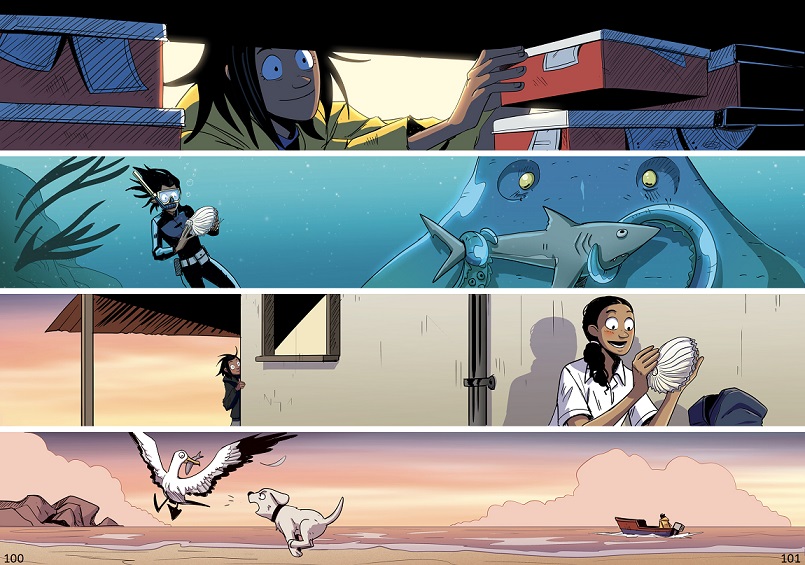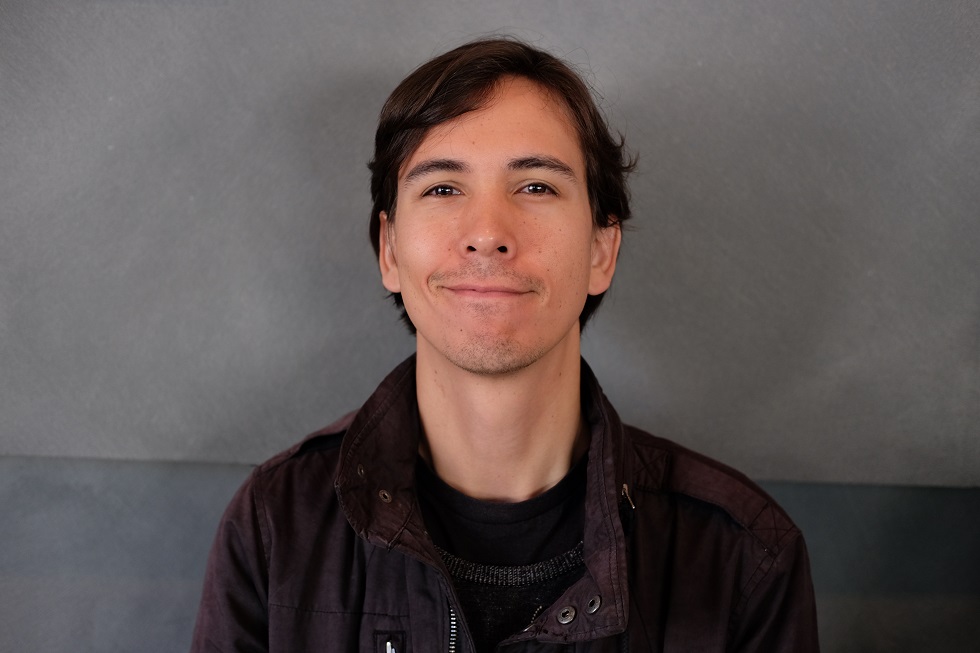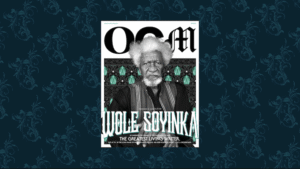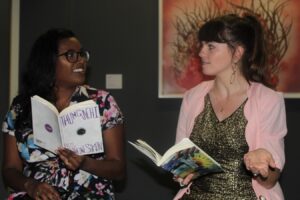Rafaella Delle Donne was poring through some 15th century illustrations, of sea monsters that European sailors claimed to have encountered, when she made an observation. The sightings, likely exaggerated, were not depicted in excitement but in perception of a threat, a reflection of Europe’s fear of the unknown. Donne, a South African comics writer, was a TV executive at Triggerfish Animation Studios’ Story Lab, which developed the Netflix series Mama K’s Team 4, and the eOne, Disney Junior, and Disney+ series Kiya & The Kimoja Heroes. For her, it was the seed of another story. She took it to Anthony Silverston, a partner and Head of Development at Triggerfish, with whom she’d cowritten feature films.
“We worked on a few versions together, with different protagonists, but when we landed on the character of Pearl, we managed to unlock what was at the heart of the story,” Delle Donne said. “Not the monsters out there, but the monsters in our heads.”
“A story about the fear of vulnerability”
To give Pearl life, Silverston dug into the personal. Like the character, he grew up in a seaside fishing village in Kalk Bay, raised by his mother. “I, too, was grappling with my own monsters, coming to terms with the fact that I was gay, and so I would retreat into myself, where I felt safe,” he said. “So, I really wanted to tell a story about the fear of vulnerability. All the characters reflect that in some way—instead of facing up to themselves, they lash out in anger, or hide from the world, limited by their own insecurities of opening up. Through their relationship, Pearl and Otto help each other face up to their fears, and grow in the process.”
Silverston and Delle Donne did not set out to make Pearl of the Sea a graphic novel. “We initially wrote it as a feature film,” Donne told me, “but knowing how long it takes to develop, finance, and produce an animated feature, we decided [on that] instead, which also gave us more creative freedom.”
They planned to finish it in four months, but that was how long it took to iron out the story with their colleague Willem Samuel, who is Head of Story at Triggerfish. Two more artists came onboard: Jessie Ochse, who inked it, and Clyde Beech, who coloured it.
“I was feeling frustrated with the sorts of stories coming out of the western animation industry”
The development of Pearl at Triggerfish brushed with another project. When Pearl was still in an earlier form and was going to be a film, illustrator Daniel Clarke and writer Daniel Snaddon, who then both worked at the company—including on its BAFTA-nominated Stick Man and its Annie Award-winning The Snail and the Whale, with Snaddon as codirector of the International Emmy winner Zog—pitched their take on the story, as a directing team. But their intended tone was too mature for what the company wanted.
“After that, I was feeling frustrated with the sorts of stories coming out of the western animation industry,” Daniel Clarke told me. Inspired by his grandfather’s tales, about the Zambezi River god Nyami Nyami, he began work on an idea of his own, about a river god and his human daughter. He was joined by Snaddon, who contributed story ideas, and his brother, writer James Clarke, who wrote it.
Their story, KARIBA, set in the 1950s, in present-day Zimbabwe, took five years; Daniel Clarke pitched Snaddon the initial art concept in 2013, James Clarke had a first draft of the book script in 2017, and Daniel Clarke finished the illustration in 2018. Triggerfish provided advice and feedback and eventually backed the independent project.
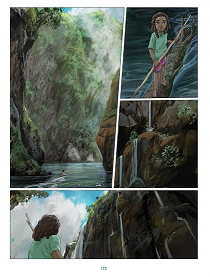

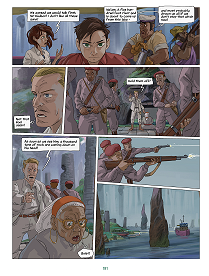

James Clarke sought out history books at the University of Cape Town’s African Studies Library. “Once we had gathered this material, some of it inspiring, some of it dispiriting, we undertook a trip to Kariba and there met and spoke with people who had worked on the dam or who knew stories from the time,” he said. “It was an informal and very low-budget trip, but no less useful or meaningful or inspiring for that.”
Snaddon said that they initially made KARIBA a graphic novel “as a first stake in the ground towards creating a hand-drawn African animated feature film.” “All three of us are great fans of Studio Ghibli, and Dan and I fell in love with the idea of making an African answer to those films,” he said. “During the process, though, Dan and James became convinced that the best way for the story to live was to make a really good graphic novel, and to lean into what the medium could offer them as storytellers.”
“A more three-dimensional experience of literature”
As graphic novels, KARIBA and Pearl of the Sea join a developing bridge between two industries: African comics, still emerging, and literature, already notable on the global level. The two will be released by Catalyst Press, an African publisher in North America, which, through its Story Press Africa imprint, a collaboration with graphics company Jive Media, put out the graphic novels Shaka Rising and King Shaka. But Catalyst Press will be publishing them not under the imprint but as part of its Panel and Page Series, which already includes the WWI adventure comic Madame Livingstone, the graphic history All Rise: Resistance and Rebellion in South Africa, and the forthcoming Chaos in Kinshasa.
The Panel and Page Series, Catalyst Press’ director Jessica Powers told me, “provides a more expansive offering and more modern-focused graphic fiction and non-fiction as well as historical.” For her, “graphic novels are an incredibly rich platform, a more three-dimensional experience of literature.” Some in the literary world agree. In 2018, the Booker Prize longlisted one: the American artist Nick Drnaso’s Sabrina.
Powers received Pearl of the Sea from a literary agent, and, while looking for a comparative title, one of her team members, Sarah Belle Selig, found a Kickstarter campaign for KARIBA, and Catalyst Press made an offer.
“We began to see the wonderful ways these two graphic novels illuminated similar themes: female heroines, water, environmental concerns, sea creatures; social issues that are germane to the place—for Pearl, it’s poverty and one-parent families, and for KARIBA, it’s displacement of Indigenous people,” Powers said. “We didn’t know at the time that the two projects had started out as one, and the collaborators saw different visions, and mutually decided to part ways and create two very different graphic novels. But now it seems absolutely perfect that they are coming back together to be published by the same publisher.”
Powers told me that the two novels, however, offer very different approaches. “The stories themselves—their plots—are uniquely and strikingly different. And they both provide different takes on these themes, and together provide a more complete picture of African experiences. The making of the Kariba dam occurred in 1955-1959, so historically, the issues faced by the people affected and displaced by the dam were very different than the issues Pearl faces in modern-day South Africa of the 2020s.”


Willem Samuel told me that, when creating the world of Pearl of the Sea, he, Silverston, and Donne wanted the visuals to be in step with the emotional journey of the book. “I think we found a wonderful balance where the simple and cartoony style can easily shift between different moods,” he said. The mood of the book, Silverston said, is “specific and unique to a South African fishing village, combining elements from places like Paternoster along the West Coast with the recognisable fishing houses of Arneston.”
The world of KARIBA, on the other hand, relied on the philosophical: it sought a truth worth sharing. “You try to stay open and sense where the story and characters want to go and follow along the best you can,” Daniel Clarke said of his general process. “At the end of the day, you also need to be entertaining but the more closely you can cleave to something real, be it psychological or archetypal, the more the reader will feel they are getting a glimpse into something real, something that actually happened.”
“With an idea, I always ask myself, what will that look like in Africa?”
The question of continentality, Africanness, looms over both novels. “Whenever I come up with an idea, whether it’s about a sea monster, or a kid with superpowers, I always ask myself, what will that look like in Africa?” Donne said about Pearl. “Even though I was born in South Africa and have lived most of my life here, my ancestry is European, so I don’t feel entitled to tell African stories or believe they are mine to tell; but I am predominantly influenced and inspired by what is happening on the continent and in South Africa, especially. When we came up with the idea of telling a story about a sea monster set in a small fishing village, it became inextricable from the story of how indigenous fishing communities have historically, and continue to be, marginalised in South Africa. My favourite review of the comic so far is by a storyteller and activist for fishing communities known as Traci Kwaai, who wrote that she could relate so strongly to the story that it made her hold her breath. That’s, ultimately, why we tell stories isn’t it?”

James Clarke said that, with KARIBA, they “tried consciously to follow our intuitions in the hope that they would guide us to a story that is true to what we know as people who were born and have lived in Africa all our lives.” It is difficult to do, he explained, as people have expectations about what a story from Africa should be. “And they are sometimes shocked to learn that these expectations do not in reality correspond to the stories that writers or artists from Africa are telling. There is a real danger of falling into the trap of playing to these expectations, for commercial or other reasons.”
Every time they work on a project, the creators of Pearl of the Sea cede space to their artistic philosophies. “Growing up, I hardly saw myself represented on screen or in literature,” said Silverston. “Or if there was a gay character, it was like their entire story was just about the struggle of dealing with their sexuality, so I always felt there was something ‘wrong’ about me. So I just want to tell stories about people who have not been represented before, to normalise everything, and help create empathy.”
Donne, who has a PhD on the intersection of African religions and popular culture, said that she “feels passionate about decolonization, one comic book or animated TV series at a time.” It is why she is happy with Catalyst Press’ approach. “They have been really receptive to themes in the comic that could have been perceived as too dark or adult for a YA audience, like the complexities of poaching, teen sexuality, and parental abandonment.” They have allowed, she said, “a balance between the light and the dark aspects of our graphic novel.”
Pearl of the Sea is Triggerfish’s first move into literature. “We had been bouncing around the idea of exploring comics and graphic novels for a long time, and this one seemed to lend itself well to the format,” Silverston said. “I’m excited about the medium and we’re already exploring doing more, working with other storytellers and artists from across the continent.” For Daniel Snaddon, “the success of the Kariba Kickstarter gave Triggerfish some confidence to explore the graphic novel route.”
Catalyst Press hopes for more collaboration between the comics and literary industries. “I’d like to see this open up space for more graphic novels from the continent, and also for those graphic novels to be animated,” Powers said. “The sheer size in number of manga and anime series are virtually impossible for anybody to compete with, but maybe we’re on the cusp of a trend across the African continent.” ♦
Catalyst Press will publish Pearl of the Sea on January 31, 2023, and KARIBA on June 6, 2023.





